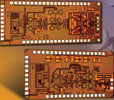

Hittite announced the release of the highly integrated HMC6000 and HMC6001 silicon transceiver chipset which targets 60 GHz applications such as metrocell/picocell backhaul, WiGig (IEEE 802.11ad) multi-Gbps solutions including wireless cable replacement (HDMI, USB 3.0, DisplayPort), wireless docking stations, video/magazine kiosks and wireless sensors.
The chipset not only solves many of the key technical challenges encountered at millimetre-wave frequencies, but also enables turnkey multi-Gbps communication links at 60 GHz. Low-frequency baseband signals are directly translated to and from 60 GHz, minimising the need for expensive or complex millimetre-wave interconnection components on the printed circuit board.
The HMC6000 transmitter IC can translate analog baseband in-phase (I) and quadrature (Q) signals to a selected channel in the 60 GHz band, requiring only an external crystal oscillator. It provides differential analog I and Q input ports with DC coupling to enable cancellation of DC offsets and carrier feed-through.
The device includes a low phase-noise frequency synthesiser for tuning across the 57 to 64 GHz band in 500 or 540 MHz steps (which represent one quarter of the IEEE channel spacing) depending upon the reference input frequency. It features as much as 38 dB gain (with 17 dB gain-control range) to achieve up to +12 dBm linear output power and +17 dBm saturated output power. The differential RF output provides a low-loss RF transition with high output efficiency.
The HMC6001 receiver IC operates with single-ended input signals from a selected channel in the 60 GHz band and down-converts them to differential analog I and Q baseband signals. The chip includes all necessary frequency generation, gain control and filtering to support RF signal bandwidths of up to 1,8 GHz.
The HMC6001 contains programmable baseband filters to set the high-pass corner frequency for removal of residual DC offset and local oscillator (LO) feed-through signals and to set the low-pass frequency for lower bandwidth signals. It exhibits a 6 dB noise figure at the maximum gain setting and provides a 65 dB gain control range in 1 dB steps.
Both the HMC6000 and HMC6001 feature integrated phase noise of -25 dBc at the 1,76 GHz WiGig symbol rates, enabling modulation formats up to 16-state quadrature amplitude modulation (16-QAM). Both ICs exhibit phase noise of typically -86 dBc/Hz at offsets 1 MHz from the carrier.
A simple four-wire digital serial interface provides full control and status reporting for these ICs, including frequency channel selection, gain control, circuit bias and filter bandwidths.
For more information contact Andrew Hutton, RF Design, +27 (0)21 555 8400, [email protected], www.rfdesign.co.za
| Tel: | +27 21 555 8400 |
| Email: | [email protected] |
| www: | www.rfdesign.co.za |
| Articles: | More information and articles about RF Design |

© Technews Publishing (Pty) Ltd | All Rights Reserved